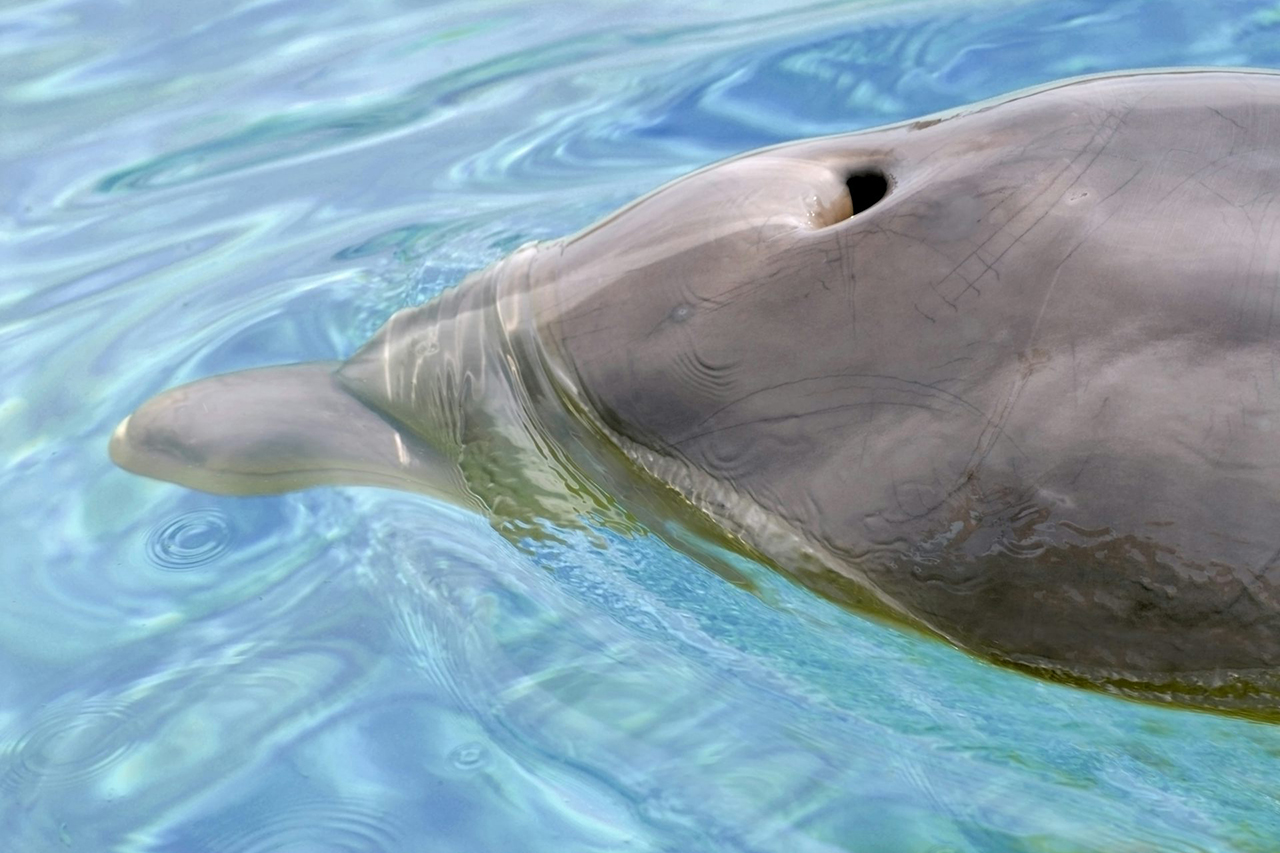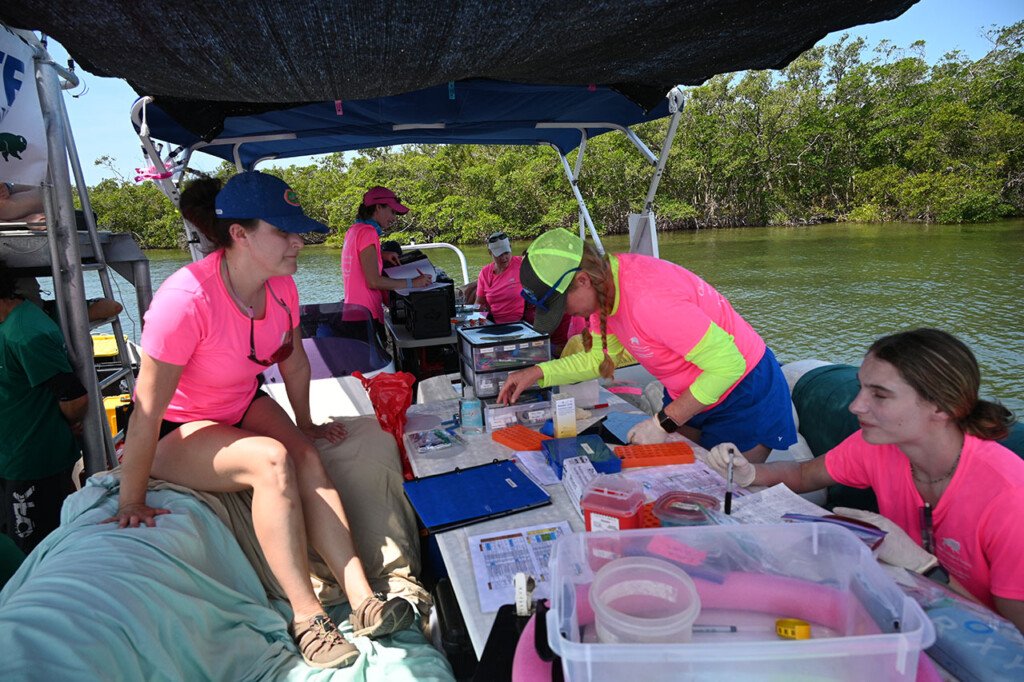CofC Faculty Study Dolphins' Exposure to Plastics
Two faculty members in the Department of Public Health Sciences and Administration are involved in research comparing concentrations of endocrine-disrupting compounds between dolphins in urban and rural areas.

Above (l–r): Leslie Hart and Miranda K. Dziobak process a control sample to help ensure chemicals in dolphin urine aren’t coming from lab tools or background contamination. (Photograph by College of Charleston HOPE Research Lab)
Dolphins that live near urban coastlines appear to be exposed more frequently to chemicals associated with plastics – called phthalates – than those living near more rural areas, according to findings from a new study published in the peer-reviewed journal Frontiers in Marine Science.*
The College of Charleston, a leader in marine science research, is at the forefront of studies on dolphins and plastics – including phthalates. The College has partnered with Brookfield Zoo Chicago’s Sarasota Dolphin Research Program since 2016.
RELATED: Find out more about the studies conducted with the Sarasota Dolphin Research Program.
Phthalates are chemicals used to make plastics more flexible and durable, and to function as solvents and stabilizers. They’ve been nicknamed the “everywhere chemical” because they’re so widespread in our daily lives. These chemicals, which are easily released into the environment as plastics break down, are found in everything from PVC pipes to food packaging to cosmetics and even perfumes. Exposure is so common that more than 95% of humans have detectible levels in their urine.
Using methods similar to those in human health studies, researchers first looked at whether there was evidence of phthalates in dolphin urine. Findings showed widespread exposure to these chemicals: 75% of Sarasota Bay dolphins are exposed to phthalates, and they have much higher levels of some of these chemicals than humans.
These ubiquitous chemicals are known endocrine disruptors that impact mammals’ hormone systems, which can cause problems with growth, fertility and reproduction. Human studies have also shown that phthalates can lead to heart problems and even neurological disorders.

This newest study, “Comparing phthalate exposure between bottlenose dolphins (Tursiops truncatus) residing in urban and rural environments,” compared phthalate concentrations in the urine of dolphins living in Sarasota Bay, Florida, which is adjacent to a highly developed, urbanized community, to dolphins living in Barataria Bay, Louisiana – a much more rural, less populated area where the dolphin population has been closely studied because it was impacted by the Deepwater Horizon oil spill.
They found that 73% of the Sarasota Bay dolphins had detectable phthalate levels compared to 33% in Barataria Bay dolphins, though the concentration levels in both populations were similar. There were also differences in the types of phthalates detected.
Urine samples in both dolphin populations had detectable concentrations of mono-2-ethylhexyl phthalate (MEHP) exposure, while only the samples from the dolphins in Sarasota Bay revealed exposure to monoethyl phthalate (MEP). MEHP is commonly associated with plastic products, such as PVC and food packaging, while MEP is commonly linked to personal care products, such as perfumes and fragranced lotions.
“That we found MEHP in both populations suggests the widespread nature of plastic pollution, while the MEP found only in the Sarasota Bay dolphins points to an association with greater human activity,” says the study’s lead author, Miranda Dziobak, public health instructor. “Both are concerning because we know that these chemicals are endocrine disruptors and if they affect dolphin reproduction, that could have population-level impacts on dolphin communities.”
The SDRP is the world’s longest-running dolphin conservation research program. The research team studies the biology, behavior, ecology, social structure, health and communication of dolphins, as well as the effects of human activities on them. The Sarasota Bay dolphins often serve as a reference population for dolphins in other locations, such as Barataria Bay, where previous studies have focused on the impacts of the Deepwater Horizon oil spill.
Those studies have produced alarming results indicating that the oil-exposed dolphin population there declined by 45% after the spill and that it remains vulnerable to emerging threats like those posed by phthalates.

“For long-lived species like dolphins, small changes in individual survival can result in big changes for a population,” says Randy Wells, director of the Brookfield Zoo Chicago’s Sarasota Dolphin Research Program. “And because there are no proven medical interventions that we can implement to address persistent diseases caused by oil exposure, resource managers have to prevent additional impacts from things that we can control. It’s important to understand how chemicals like phthalates leaching into aquatic ecosystems are impacting the animals there so we can address them.”
Studies of phthalate impacts on dolphins are ongoing and, with funding from Sea Grant (Award No. NA22OAR4170655 – CFDA #11.417), researchers are currently looking at whether environmental factors – specifically rainfall, large storm events and harmful algal blooms – may impact contaminant levels in dolphins, according to Leslie Hart, associate professor of public health education at the College of Charleston, who has been leading studies of dolphins, phthalates and plastics in partnership with the SDRP since 2016.
“Because the Sarasota Bay dolphin community is so well known and so well studied – and it’s a relatively healthy population – it can serve as a reference population to help us better understand health differences in other places, like Barataria Bay,” Hart says. “And with 55-plus years of data on the Sarasota dolphins themselves, we can also address new questions as they emerge.”
Research reported in this publication was supported by the National Institute of Environmental Health Sciences of the National Institutes of Health under Award No. R15ES034169. The content is solely the responsibility of the authors and does not necessarily represent the official views of the National Institutes of Health.
*Study Citation: Dziobak, M.K.; Curtin, T.; Wells, R.S.; Takeshita, R.; Smith, C.R., Zolman, E.; Toms, C.N.; Allen, R.F.; and Hart, L.B. (2025) Comparing phthalate exposure between bottlenose dolphins (Tursiops truncatus) residing in urban and rural environments. Front. Mar. Sci. 12:1554075. doi: 10.3389/fmars.2025.1554075



